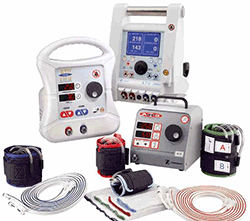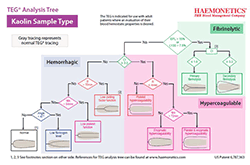What's New in Trauma
GE VScan
 Life Line in Terra Haute is using a GE VScan, a pocket-sized visualization tool providing black and white anatomic images and color-coded Doppler blood flow images in real time. It’s being integrated into physical examinations allowing Life Line to add a visual inspection of the inside of the body. The images are generated based on ultrasound technology. Vscan is pocket-sized and helps to enable personalized use at the point of care. It will be used by Life Line for trauma patients to assess for blood in the abdomen or pneumothoraces, to look at the heart wall motion and vavle competency in cardiac patients, to assure the fetal viability of pregnant patients, and to help put IVs into patients with veins that hide. If a patient has evidence of blood in their abdomen and are hypotensive, the will be directed to the operating room upon landing, rather than going to the ED for assessment. This should decrease time to operative repair, and decrease the number of critical patients who die!
Life Line in Terra Haute is using a GE VScan, a pocket-sized visualization tool providing black and white anatomic images and color-coded Doppler blood flow images in real time. It’s being integrated into physical examinations allowing Life Line to add a visual inspection of the inside of the body. The images are generated based on ultrasound technology. Vscan is pocket-sized and helps to enable personalized use at the point of care. It will be used by Life Line for trauma patients to assess for blood in the abdomen or pneumothoraces, to look at the heart wall motion and vavle competency in cardiac patients, to assure the fetal viability of pregnant patients, and to help put IVs into patients with veins that hide. If a patient has evidence of blood in their abdomen and are hypotensive, the will be directed to the operating room upon landing, rather than going to the ED for assessment. This should decrease time to operative repair, and decrease the number of critical patients who die!
A.T.S 1200
 IU Health Methodist Hospital Trauma Team has started using A.T.S 1200 on trauma patients that require bleeding control on limbs. A.T.S 1200 is a tourniquet system which applies circumferential pressure to a limb in order to temporarily occlude venous and arterial circulation to that particular extremity. Trauma has found it beneficial for the patients because tourniquet pressure is of considerable concern due to the potential complications which may arise as a result. Lower tourniquet pressures are associated with a lower risk of nerve-related injuries and other complications, as well as less perceived postoperative pain. (Click on the picture to learn more about Zimmer’s A.T.S 1200)
IU Health Methodist Hospital Trauma Team has started using A.T.S 1200 on trauma patients that require bleeding control on limbs. A.T.S 1200 is a tourniquet system which applies circumferential pressure to a limb in order to temporarily occlude venous and arterial circulation to that particular extremity. Trauma has found it beneficial for the patients because tourniquet pressure is of considerable concern due to the potential complications which may arise as a result. Lower tourniquet pressures are associated with a lower risk of nerve-related injuries and other complications, as well as less perceived postoperative pain. (Click on the picture to learn more about Zimmer’s A.T.S 1200)
Thrombo Elasto Graphy
 The IU Health Methodist Trauma Team have added TEG testing to their arsenal of tools to provide the best care for trauma patients.
TEG stands for: Thrombo Elasto Graphy.
The IU Health Methodist Trauma Team have added TEG testing to their arsenal of tools to provide the best care for trauma patients.
TEG stands for: Thrombo Elasto Graphy.
What does the TEG test tell about trauma?
TEG is a blood test that helps surgeons assess trauma induced coagulopathy and be able to better direct hemostatic resuscitation: So the right amount and the right type of blood products are chosen specific to the patient’s needs.
(click in the diagram to enlarge)

What problem does TEG help to solve?
Venous clots are common following trauma due to the body’s tendency to overcompensate to control hemorrhage. Choosing the right blood products in the right amount at the right time is important. TEG Testing is a helpful tool for surgeon decision making.
Does the TEG test change Pre-hospital care?
No. Timely, organized on-scene trauma care, in conjunction with rapid, safe transport to an appropriate trauma care destination is still the top priority in trauma care!